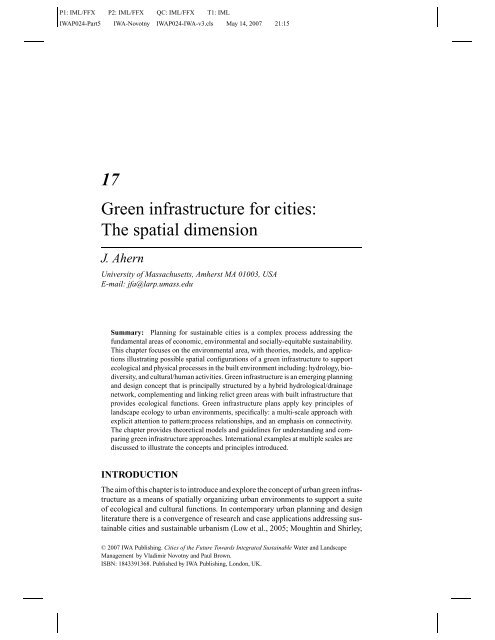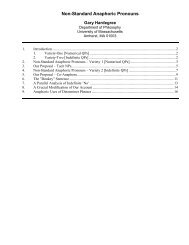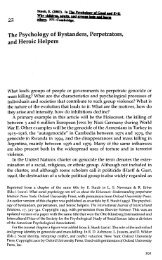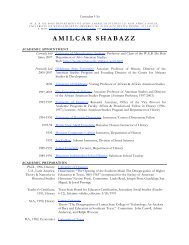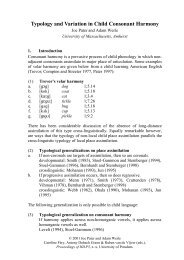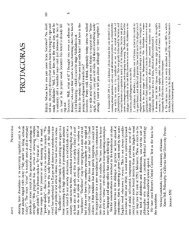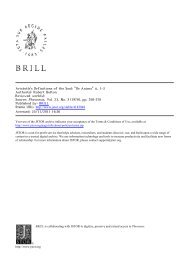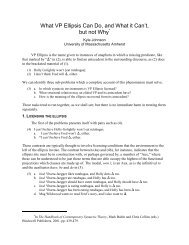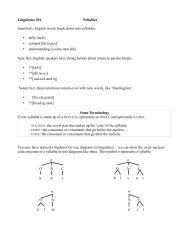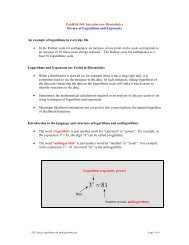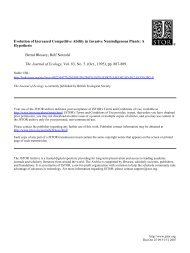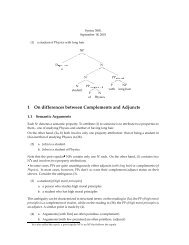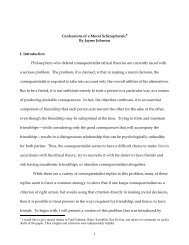Green infrastructure for cities: The spatial dimension - University of ...
Green infrastructure for cities: The spatial dimension - University of ...
Green infrastructure for cities: The spatial dimension - University of ...
Create successful ePaper yourself
Turn your PDF publications into a flip-book with our unique Google optimized e-Paper software.
P1: IML/FFX P2: IML/FFX QC: IML/FFX T1: IML<br />
IWAP024-Part5 IWA-Novotny IWAP024-IWA-v3.cls May 14, 2007 21:15<br />
17<br />
<strong>Green</strong> <strong>infrastructure</strong> <strong>for</strong> <strong>cities</strong>:<br />
<strong>The</strong> <strong>spatial</strong> <strong>dimension</strong><br />
J. Ahern<br />
<strong>University</strong> <strong>of</strong> Massachusetts, Amherst MA 01003, USA<br />
E-mail: jfa@larp.umass.edu<br />
Summary: Planning <strong>for</strong> sustainable <strong>cities</strong> is a complex process addressing the<br />
fundamental areas <strong>of</strong> economic, environmental and socially-equitable sustainability.<br />
This chapter focuses on the environmental area, with theories, models, and applications<br />
illustrating possible <strong>spatial</strong> configurations <strong>of</strong> a green <strong>infrastructure</strong> to support<br />
ecological and physical processes in the built environment including: hydrology, biodiversity,<br />
and cultural/human activities. <strong>Green</strong> <strong>infrastructure</strong> is an emerging planning<br />
and design concept that is principally structured by a hybrid hydrological/drainage<br />
network, complementing and linking relict green areas with built <strong>infrastructure</strong> that<br />
provides ecological functions. <strong>Green</strong> <strong>infrastructure</strong> plans apply key principles <strong>of</strong><br />
landscape ecology to urban environments, specifically: a multi-scale approach with<br />
explicit attention to pattern:process relationships, and an emphasis on connectivity.<br />
<strong>The</strong> chapter provides theoretical models and guidelines <strong>for</strong> understanding and comparing<br />
green <strong>infrastructure</strong> approaches. International examples at multiple scales are<br />
discussed to illustrate the concepts and principles introduced.<br />
INTRODUCTION<br />
<strong>The</strong> aim <strong>of</strong> this chapter is to introduce and explore the concept <strong>of</strong> urban green <strong>infrastructure</strong><br />
as a means <strong>of</strong> <strong>spatial</strong>ly organizing urban environments to support a suite<br />
<strong>of</strong> ecological and cultural functions. In contemporary urban planning and design<br />
literature there is a convergence <strong>of</strong> research and case applications addressing sustainable<br />
<strong>cities</strong> and sustainable urbanism (Low et al., 2005; Moughtin and Shirley,<br />
C○ 2007 IWA Publishing. Cities <strong>of</strong> the Future Towards Integrated Sustainable Water and Landscape<br />
Management by Vladimir Novotny and Paul Brown.<br />
ISBN: 1843391368. Published by IWA Publishing, London, UK.
P1: IML/FFX P2: IML/FFX QC: IML/FFX T1: IML<br />
IWAP024-Part5 IWA-Novotny IWAP024-IWA-v3.cls May 14, 2007 21:15<br />
268 J. Ahern<br />
2005; Wooley, 2003; Steiner, 2002; Beatley, 2000; Van der Ryn and Cowan, 1996;<br />
Hough, 1995). This emerging focus reflects a broader international awareness <strong>of</strong><br />
sustainability across its basic tripartite <strong>dimension</strong>s: economy, environment and (social)<br />
equity – <strong>of</strong>ten known as the “three E’s” <strong>of</strong> sustainability (Wheeler and Beatley,<br />
2000). As the sustainable development concept has matured and gained greater<br />
acceptance over the past two decades, it has directly and increasingly influenced regional<br />
and municipal policy and plans (Benedict and McMahon, 2006). As with the<br />
tripartite principles <strong>of</strong> sustainability, the policies and plans developed to advance<br />
urban sustainability through policy and practice address the economic, social, and<br />
environmental <strong>dimension</strong>s <strong>of</strong> sustainability. This chapter focuses primarily on the<br />
environmental <strong>dimension</strong> <strong>of</strong> urban sustainability, and more specifically, the role <strong>of</strong><br />
<strong>spatial</strong> configuration <strong>of</strong> the urban environment in supporting key ecological functions<br />
through a “green <strong>infrastructure</strong>” in a sustainable manner. In addition, green<br />
<strong>infrastructure</strong> is also presented as a strategy to achieve abiotic, biotic and cultural<br />
goals. <strong>The</strong> chapter starts with a review <strong>of</strong> key ecological processes and principles<br />
<strong>of</strong> landscape ecology, with respect to sustainable planning, and <strong>of</strong> the particular<br />
importance <strong>of</strong> <strong>spatial</strong> configuration <strong>of</strong> urban environments.<br />
KEY ECOLOGICAL PROCESSES AND FUNCTIONS<br />
Ecological processes are the mechanisms by which landscapes function – over<br />
time, and across space – and are there<strong>for</strong>e appropriate to use as the goals <strong>for</strong> –<br />
and the indicators <strong>of</strong> – sustainability. Landscape ecology provides a theoretical<br />
perspective and the analytical tools to understand how complex and diverse landscapes,<br />
including urban environments function with respect to specific ecological<br />
processes (Pickett et al., 2004).<br />
<strong>The</strong> Ecological Society <strong>of</strong> America defines ecological functions as those that<br />
provide “services” that moderate climatic extremes, cycle nutrients, detoxify<br />
wastes, control pests, maintain biodiversity and purify air and water (among other<br />
services) (ESA, 2006). <strong>The</strong> ecosystem services concept helps to place value on<br />
ecological functions, <strong>of</strong>ten to the direct benefit <strong>of</strong> human populations in physical<br />
health, economic or social terms.<br />
A widely accepted resource model <strong>for</strong> landscape planning is the Abiotic, Biotic<br />
and Cultural (ABC) resource model (Ndubisi, 2002; Ahern, 1995). This comprehensive<br />
and inclusive model is consistent with the landscape ecology perspective<br />
that explicitly recognizes the needs and reciprocal impacts <strong>of</strong> humans on biotic<br />
and abiotic systems and processes. <strong>The</strong> ABC resource model is applied here to<br />
articulate the key ecological functions <strong>of</strong> a green urban <strong>infrastructure</strong> (Table 17.1).<br />
<strong>The</strong> ABC functions described in Table 17.1 are intended to be illustrative, but<br />
not comprehensive. It is important to note how this broad, multipurpose, and multifunctional<br />
suite <strong>of</strong> ecological and cultural functions supports the broad principles<br />
<strong>of</strong> sustainability, in contrast with single-purpose policies or plans that address<br />
more focused goals (e.g. managing water quality, endangered species protection<br />
or pollution remediation). And because this suite <strong>of</strong> functions spans an abioticbiotic-cultural<br />
continuum – it is inherently more likely to enjoy a broad base <strong>of</strong>
P1: IML/FFX P2: IML/FFX QC: IML/FFX T1: IML<br />
IWAP024-Part5 IWA-Novotny IWAP024-IWA-v3.cls May 14, 2007 21:15<br />
<strong>Green</strong> <strong>infrastructure</strong> <strong>for</strong> <strong>cities</strong>: <strong>The</strong> <strong>spatial</strong> <strong>dimension</strong> 269<br />
Table 17.1. Key abiotic, biotic and cultural functions <strong>of</strong> a green urban <strong>infrastructure</strong><br />
Abiotic Biotic Cultural<br />
Surface:groundwater Habitat <strong>for</strong> generalist Direct experience <strong>of</strong><br />
interactions<br />
species<br />
natural ecosystems<br />
Soil development process Habitat <strong>for</strong> specialist<br />
species<br />
Physical recreation<br />
Maintenance <strong>of</strong><br />
Species movement routes Experience and<br />
hydrological regime(s) and corridors<br />
interpretation <strong>of</strong> cultural<br />
history<br />
Accommodation <strong>of</strong> Maintenance <strong>of</strong><br />
Provide a sense <strong>of</strong> solitude<br />
disturbance regime(s) disturbance and<br />
successional regimes<br />
and inspiration<br />
Buffering <strong>of</strong> nutrient Biomass production Opportunities <strong>for</strong> healthy<br />
cycling<br />
social interactions<br />
Sequestration <strong>of</strong> carbon Provision <strong>of</strong> genetic Stimulus <strong>of</strong><br />
and (greenhouse gasses) reserves<br />
artistic/abstract<br />
expression(s)<br />
Modification and<br />
Support <strong>of</strong> flora:fauna Environmental education<br />
buffering <strong>of</strong> climatic<br />
extremes<br />
interactions<br />
This figure articulates what a green urban <strong>infrastructure</strong> can explicitly do to contribute to sustainability.<br />
public support – an essential characteristic <strong>for</strong> a successful urban sustainability<br />
program.<br />
LANDSCAPE ECOLOGY PRINCIPLES FOR GREEN<br />
URBAN INFRASTRUCTURE<br />
Key ideas from landscape ecology that are relevant to green urban <strong>infrastructure</strong><br />
<strong>for</strong> sustainable <strong>cities</strong> include: a multi-scale approach with an explicit recognition<br />
<strong>of</strong> pattern:process relationships and an emphasis on physical and functional<br />
connectivity.<br />
A multi-scaled approach is based on hierarchy theory that addresses the structure<br />
and behavior <strong>of</strong> systems that function simultaneously at multiple scales. For<br />
example, hierarchy theory is widely used in transportation planning, <strong>for</strong> to understand<br />
the dynamics and capacity <strong>of</strong> local road traffic, one must understand the<br />
larger highway system with which local roads are connected. <strong>The</strong> same applies<br />
to landscapes which are also hierarchical systems. While landscapes are, by definition,<br />
broad heterogeneous areas <strong>of</strong> land, they are also by definition “nested”<br />
within larger areas <strong>of</strong> land that <strong>of</strong>ten constrain, or control the ecological processes<br />
– particularly those associated with species movement or hydrological processes.<br />
In applied landscape ecology, a multi-scaled approach – addressing <strong>spatial</strong> patterns<br />
and ecological processes – is the accepted norm (Leitão and Ahern, 2002;<br />
Ndubisi, 2002). <strong>The</strong> multi-scaled approach involves assessment and planning <strong>of</strong>
P1: IML/FFX P2: IML/FFX QC: IML/FFX T1: IML<br />
IWAP024-Part5 IWA-Novotny IWAP024-IWA-v3.cls May 14, 2007 21:15<br />
270 J. Ahern<br />
<strong>spatial</strong> configuration <strong>of</strong> landscape patterns and ecological processes at multiple<br />
scales, and how these patterns and processes interact. This analysis typically indicates<br />
key points <strong>for</strong> physical linkages, where important connections exist, or where<br />
connections should be made. In urban environments the appropriate scales are: the<br />
metropolitan region or city, the districts or neighborhoods, and individual sites.<br />
<strong>The</strong> pattern:process dynamic is arguably the fundamental axiom <strong>of</strong> landscape<br />
ecology because the <strong>spatial</strong> composition and configuration <strong>of</strong> landscape elements<br />
directly determines how landscapes function, particularly in terms <strong>of</strong> species movement,<br />
nutrient and water flows (Turner, 1989). Because landscape pattern and<br />
process are highly interrelated and interdependent, both must be understood to<br />
plan <strong>for</strong> sustainability. Landscape architects, and applied landscape ecologists<br />
have advanced theories, guidelines and models <strong>for</strong> landscape patterns that support<br />
a desired, or maximum level <strong>of</strong> ecological functions in a sustainable manner<br />
(Dramstad et al., 1996). <strong>The</strong> ecological network concept, in particular, has been<br />
implemented worldwide to address the intriguing promise <strong>of</strong> an optimal <strong>spatial</strong><br />
strategy at broad scales including continents, nations and regions (Jongman and<br />
Pungetti, 2004). <strong>The</strong> ecological network concept, however, has aimed primarily at<br />
maintaining biodiversity and has been rarely applied in urban contexts. This trend<br />
is changing with a focus on urban environments through the green <strong>infrastructure</strong><br />
movement.<br />
Connectivity is a property <strong>of</strong> landscapes that illustrates the relationship between<br />
landscape structure and function. In general, connectivity refers to the degree to<br />
which a landscape facilitates or impedes the flow <strong>of</strong> energy, materials, nutrients,<br />
species, and people across a landscape. Connectivity is an emergent property <strong>of</strong><br />
landscapes that results from the interaction <strong>of</strong> landscape structure and function,<br />
<strong>for</strong> example: water flow, nutrient cycling and the maintenance <strong>of</strong> biological diversity<br />
(Leitão et al., 2006). In highly modified landscapes, and especially in urban<br />
environments, connectivity is greatly reduced, <strong>of</strong>ten resulting in fragmentation –<br />
the separation and isolation <strong>of</strong> landscape elements with significant impacts on the<br />
ecological processes that require connectivity. <strong>The</strong> concept <strong>of</strong> connectivity applies<br />
directly to water flow, arguably the most important flow in any landscape, particularly<br />
in human-dominated and urban environments. Disruption <strong>of</strong> hydrologic<br />
connectivity is a major concern when planning <strong>for</strong> sustainability. Because human<br />
culture relies on water in many respects, maintaining a connected and healthy<br />
hydrological system supports multiple ABC functions. In urban, or built environments,<br />
roads represent the greatest barrier to connectivity and are the primary<br />
contributor to fragmentation (Forman et al., 2003).<br />
Spatial configuration<br />
With an understanding <strong>of</strong> ecological processes, the pattern:process dynamic and<br />
the importance <strong>of</strong> connectivity, <strong>spatial</strong> configuration is the point <strong>of</strong> integration.<br />
In applied landscape ecology, the mosaic model <strong>for</strong> describing and understanding<br />
the <strong>spatial</strong> configuration <strong>of</strong> landscapes is almost universally accepted. <strong>The</strong> model<br />
uses three fundamental landscape elements to define landscape structure: patches,
P1: IML/FFX P2: IML/FFX QC: IML/FFX T1: IML<br />
IWAP024-Part5 IWA-Novotny IWAP024-IWA-v3.cls May 14, 2007 21:15<br />
<strong>Green</strong> <strong>infrastructure</strong> <strong>for</strong> <strong>cities</strong>: <strong>The</strong> <strong>spatial</strong> <strong>dimension</strong> 271<br />
Table 17.2. Examples <strong>of</strong> Urban Landscape Elements Classified in the<br />
Patch-Corridor-Matrix Model<br />
Urban Patches Urban Corridors Urban Matrix<br />
• Parks • Rivers • Residential Neighborhoods<br />
• Sportsfields • Canals • Industrial Districts<br />
• Wetlands • Drainageways • Waste Disposal Areas<br />
• Community Gardens • Riverways • Commercial Areas<br />
• Cemeteries • Roads • Mixed Use Districts<br />
• Campuses • Powerlines<br />
• Vacant Lots<br />
Table 17.3. A typology <strong>of</strong> planning strategies, illustrating the range <strong>of</strong> actions that<br />
planners and designers routinely practice (Ahern 1995)<br />
Protective Defensive<br />
Taking preventative actions to preserve<br />
well functioning, intact landscape<br />
elements be<strong>for</strong>e they are threatened by<br />
change or development:<br />
Implementing actions to defend landscape<br />
elements that are suffering from<br />
development pressure:<br />
• World Heritage Areas • Regional, local parks<br />
• National Parks • Buffer zones<br />
• “Big” patches <strong>of</strong> native vegetation • Environmental impact mitigation<br />
• Nature preserves • Corridors that are pressuredfrom<br />
adjacent land use(s)<br />
Offensive Opportunistic<br />
Taking remedial or restorative actions to<br />
reintroduce Abiotic, Biotic or Cultural<br />
functions where they do not currently<br />
exist:<br />
Recognizing the potential <strong>for</strong><br />
non-contributing landscape elements to<br />
be managed or structured differently to<br />
provide specific functions.<br />
• Ecological restoration • Many greenways<br />
• Brownfields • Most urban/green <strong>infrastructure</strong><br />
• Daylighted streams • Transportation and utility <strong>infrastructure</strong><br />
• Bioremediation<br />
corridors, and the matrix. A patch is a relatively homogeneous nonlinear area that<br />
differs from its surroundings. Patches provide multiple functions including wildlife<br />
habitat, aquifer recharge areas, or sources and sinks <strong>for</strong> species or nutrients. A<br />
corridor is a linear area <strong>of</strong> a particular land cover type that is different in content<br />
and physical structure from its context (Forman, 1995). Corridors serve many<br />
functions within the landscape including habitat <strong>for</strong> wildlife, pathways or conduits<br />
<strong>for</strong> the movement <strong>of</strong> plants, animals, nutrients, and wind, or as barriers to such<br />
movement. <strong>The</strong> matrix is the dominant land cover type in terms <strong>of</strong> area, degree<br />
<strong>of</strong> connectivity and continuity, and control that is exerted over the dynamics <strong>of</strong><br />
the landscape (Forman, 1995; Forman and Godron, 1986). Table 17.2 provides<br />
examples <strong>of</strong> urban landscape elements classified in the Patch-Corridor-Matrix<br />
Model.
P1: IML/FFX P2: IML/FFX QC: IML/FFX T1: IML<br />
IWAP024-Part5 IWA-Novotny IWAP024-IWA-v3.cls May 14, 2007 21:15<br />
272 J. Ahern<br />
Figure 17.1. A continuum <strong>of</strong> hydrological/stream types and associated abiotic, biotic and<br />
cultural functions<br />
Figure 17.1 presents a continuum <strong>of</strong> urban water courses from highly engineered,<br />
linear sewers to diverse meandering river channels. Note how the associated<br />
ABC functions respond differently across the continuum. For example,<br />
streams with lower biological value may have relatively high cultural value, and<br />
high biological functions may have lower cultural functional value. <strong>The</strong> implications<br />
being that planning and management need to consider, and employ a mixed<br />
range <strong>of</strong> hydrological types to provide a complete suite <strong>of</strong> ABC functions as part <strong>of</strong><br />
a sustainable urban landscape. And important to accept reduced or minimal values<br />
on one category if valued functions are provided in other areas.<br />
Forman’s “indispensable patterns” are perhaps the most succinct, compelling<br />
and memorable <strong>of</strong> the landscape ecology-based guidelines (Forman, 1995) as<br />
shown in Figure 17.2. <strong>The</strong>se indispensable patterns are equally relevant in urban<br />
environments as they are in landscapes that are less dominated by human development<br />
and built <strong>infrastructure</strong>. Forman argues that these patterns are fundamental,<br />
<strong>for</strong> without them specific ecological functions will not be supported.<br />
GUIDELINES FOR PLANNING AND DESIGNING A<br />
GREEN URBAN INFRASTRUCTURE<br />
As discussed above, landscape ecology provides scientifically-based principles<br />
<strong>for</strong> landscape planning including a multi-scaled perspective, recognition <strong>of</strong>
P1: IML/FFX P2: IML/FFX QC: IML/FFX T1: IML<br />
IWAP024-Part5 IWA-Novotny IWAP024-IWA-v3.cls May 14, 2007 21:15<br />
<strong>Green</strong> <strong>infrastructure</strong> <strong>for</strong> <strong>cities</strong>: <strong>The</strong> <strong>spatial</strong> <strong>dimension</strong> 273<br />
Figure 17.2. Forman’s “indispensable” patterns <strong>for</strong> planning a landscape: (1) large<br />
patches <strong>of</strong> natural vegetation, (2) stream/river corridor, (3) connectivity between patches<br />
and stepping stones, and (4) small “bits <strong>of</strong> nature” (Forman, 1995, p. 452)<br />
pattern:process relationships, the fundamental importance <strong>of</strong> connectivity and specific<br />
guidelines <strong>for</strong> planning the <strong>spatial</strong> configuration <strong>of</strong> landscapes. To successfully<br />
apply these principles in landscape or urban planning, they must be associated with,<br />
and related to planning guidelines which enable the “good science” <strong>of</strong> landscape<br />
ecology to be effectively applied in the service <strong>of</strong> sustainability. Following are five<br />
proposed guidelines <strong>for</strong> planning and designing a green urban <strong>infrastructure</strong> based<br />
on landscape ecology principles.<br />
1. Articulate a <strong>spatial</strong> concept<br />
Spatial concepts guide, inspire and communicate the essence <strong>of</strong> a plan or planning<br />
strategy to provide <strong>for</strong> specific ABC functions. Spatial concepts are <strong>of</strong>ten articulated<br />
as metaphors that are highly imaginable and understandable by the public, but<br />
which also can support and inspire the planning process (Zonneveld, 1991). Examples<br />
include: “green heart”, “ring city”, and “edge city”. <strong>The</strong> green heart <strong>spatial</strong><br />
concept, <strong>for</strong> example, has guided national and regional planning in the Netherlands<br />
<strong>for</strong> decades by protecting a mostly agricultural “green heart” surrounded by a ring<br />
<strong>of</strong> urbanization including the <strong>cities</strong> <strong>of</strong> Amsterdam, Rotterdam and Utrecht. Spatial<br />
concepts are well understood in planning, but less so in science. <strong>The</strong>y represent an<br />
important interface <strong>of</strong> empirical and intuitive knowledge through which rational<br />
knowledge is complemented with creative insights. Spatial concepts are essential<br />
tools <strong>for</strong> proactive, or innovative planning, and can structure and inspire the planning<br />
process, particularly with respect to achieving genuine and effective public<br />
participation.
P1: IML/FFX P2: IML/FFX QC: IML/FFX T1: IML<br />
IWAP024-Part5 IWA-Novotny IWAP024-IWA-v3.cls May 14, 2007 21:15<br />
274 J. Ahern<br />
2. Strategic thinking<br />
Employ a strategic approach, appropriate to the <strong>spatial</strong> context and planning<br />
goals, potentially including: protective, defensive, <strong>of</strong>fensive or opportunistic strategies<br />
(Ahern, 1995). Defining these strategies also helps to place the planning<br />
activity within a broader context that is particularly relevant when planning<br />
methods are transferred or adopted <strong>for</strong> use in different locations, contexts or<br />
<strong>for</strong> different applications. A planner should be aware <strong>of</strong> the macro drivers <strong>of</strong><br />
change in a given landscape with respect to the goals <strong>of</strong> a particular plan.<br />
This awareness is the basis <strong>for</strong> in<strong>for</strong>ming a planner’s choice <strong>of</strong>, or combination<br />
<strong>of</strong>, methods, and <strong>for</strong> engaging the appropriate participants in the planning<br />
process.<br />
When the existing landscape supports sustainable processes and patterns, a<br />
protective strategy may be employed. Essentially, this strategy defines an eventual,<br />
or optimal landscape pattern that is proactively protected from change while<br />
the landscape around it may be allowed to change. Benton MacKaye’s (1928)<br />
vision <strong>of</strong> a metropolitan open space system structured by a system <strong>of</strong> protected<br />
“dams” and “levees” is a classic example from North America. It can be effective<br />
to prevent landscape fragmentation in urbanizing landscapes by pre-defining a<br />
patch and corridor network <strong>for</strong> protection. This strategy employs planning knowledge,<br />
regulation, and land acquisition to achieve the desired <strong>spatial</strong> configuration<br />
(goal).<br />
When the existing landscape is already fragmented, and core areas already<br />
limited in area and isolated, a defensive strategy is <strong>of</strong>ten applied. This strategy<br />
seeks to arrest /control the negative processes <strong>of</strong> fragmentation or urbanization.<br />
As a last resort, the defensive strategy is <strong>of</strong>ten necessary, but it can also be seen as<br />
a reactionary strategy which attempts to “catch up with” or “put on the brakes”,<br />
against the inevitable process <strong>of</strong> landscape change, in defense <strong>of</strong> an ever-decreasing<br />
nature (Sijmons, 1990).<br />
An <strong>of</strong>fensive strategy is based on a vision, or a possible landscape configuration<br />
that is articulated, understood and accepted as a goal. <strong>The</strong> <strong>of</strong>fensive strategy differs<br />
from protective and defensive strategies in that it employs restoration, or reconstruction,<br />
to re-build landscape elements in previously disturbed or fragmented<br />
landscapes. <strong>The</strong> <strong>of</strong>fensive strategy relies on planning knowledge, knowledge <strong>of</strong><br />
ecological restoration, and significant public support/ funding. It requires, by definition,<br />
the displacement, or replacement <strong>of</strong> intensive land uses (e.g. urbanization,<br />
agriculture) with extensive land uses, green corridors or new open spaces in urban<br />
areas.<br />
A landscape <strong>of</strong>ten contains unique elements or configurations that represent<br />
special opportunities <strong>for</strong> sustainable landscape planning. <strong>The</strong>se unique elements<br />
may or may not be optimally located, but represent the potential to provide particular<br />
desired functions. <strong>The</strong> opportunistic strategy is conceptually aligned with<br />
the concept <strong>of</strong> green <strong>infrastructure</strong> by seeking new or innovative “opportunities”<br />
to provide ABC functions in association with urban <strong>infrastructure</strong>.
P1: IML/FFX P2: IML/FFX QC: IML/FFX T1: IML<br />
IWAP024-Part5 IWA-Novotny IWAP024-IWA-v3.cls May 14, 2007 21:15<br />
<strong>Green</strong> <strong>infrastructure</strong> <strong>for</strong> <strong>cities</strong>: <strong>The</strong> <strong>spatial</strong> <strong>dimension</strong> 275<br />
3. <strong>The</strong> greening <strong>of</strong> <strong>infrastructure</strong><br />
To achieve sustainability in urban landscapes, <strong>infrastructure</strong> must be conceived<br />
<strong>of</strong>, and understood as a genuinely possible means to improve, and contribute to<br />
sustainability. If one only thinks about avoiding or minimizing impact related<br />
to <strong>infrastructure</strong> development, the possibility to innovate is greatly diminished.<br />
Stormwater management provides a good example. Until recently, stormwater<br />
management aimed at controlling development-related stormwater management<br />
at pre-development levels. This “damage control” mentality produced the familiar<br />
sterile, unvegetated, inaccessible stormwater retention and detention ponds that<br />
are common throughout the USA. While this stormwater <strong>infrastructure</strong> accomplished<br />
the primary goal <strong>of</strong> controlling run<strong>of</strong>f, it failed to provide other ABC<br />
functions (water quality, ecological integrity). In contrast, consider a “green <strong>infrastructure</strong>”<br />
stormwater system that incorporates green ro<strong>of</strong>s, infiltration wells,<br />
vegetated bioswales, small ponds and created wetlands. This <strong>infrastructure</strong> adds a<br />
wealth <strong>of</strong> ABC functions to the stormwater system and improves liveability (van<br />
Bohemen, 2002).<br />
4. Plan <strong>for</strong> multiple use<br />
As discussed above under planning strategies, planning and implementing urban<br />
<strong>infrastructure</strong> presents a fundamental <strong>spatial</strong> challenge: how can new functions<br />
be added when the built environment has already displaced or replaced “natural”<br />
areas and functions? It is naive and impractical to believe that stakeholders<br />
and decision-makers will make sweeping substitutions <strong>of</strong> built <strong>for</strong>ms with green<br />
areas, regardless <strong>of</strong> how committed to sustainability they are. <strong>The</strong> political, economic<br />
and social costs <strong>of</strong> such wholesale replacements are too great. Rather, it<br />
is incumbent on planners and designers to think strategically to find new ways to<br />
reconceive “grey” <strong>infrastructure</strong> to provide <strong>for</strong> sustainable ABC functions. This<br />
can be accomplished by intertwining/combining functions (Tjalllingii, 2000), as<br />
described above <strong>for</strong> stormwater management. Another design strategy is vertical<br />
integration, where multiple functions can be “stacked” in one location, as with<br />
wildlife crossings under/over roads, infiltration systems beneath building or parking<br />
lots, or green ro<strong>of</strong>s on buildings (van Boheman, 2002). Innovative scheduling<br />
can also be employed to take integrate and coordinate the time <strong>dimension</strong> <strong>of</strong> ABC<br />
functions. Examples <strong>of</strong> <strong>infrastructure</strong> scheduling include limited human use <strong>of</strong><br />
hydrological systems during periods <strong>of</strong> high flows, restrictions <strong>of</strong> recreational use<br />
<strong>of</strong> habitat areas during sensitive breeding periods, or the closing <strong>of</strong> roads at night<br />
when nocturnal species movement is concentrated. Planning <strong>for</strong> multiple use <strong>of</strong><br />
green <strong>infrastructure</strong> can also be a useful strategy <strong>for</strong> cost effectiveness and <strong>for</strong><br />
building a broad constituency <strong>of</strong> public support.<br />
5. Learn by doing<br />
A fundamental challenge and impediment to applying landscape ecology-based<br />
principles is the common lack <strong>of</strong> empirical evidence <strong>of</strong> the effectiveness <strong>of</strong> a given
P1: IML/FFX P2: IML/FFX QC: IML/FFX T1: IML<br />
IWAP024-Part5 IWA-Novotny IWAP024-IWA-v3.cls May 14, 2007 21:15<br />
276 J. Ahern<br />
intervention in a specific location. Wildlife corridors provide an example. While<br />
corridors have been implemented across the world to move species across agricultural<br />
and suburban locations (Bennett, 1999), the recommendations <strong>for</strong> corridor<br />
width, length or structure are specific to the particular species and the landscape<br />
context involved. Thus, a corridor system <strong>for</strong> Koalas in Australia, has questionable<br />
transferability <strong>for</strong> planning a moose corridor in the northeastern USA. <strong>The</strong><br />
dilemma faced by planners is that the specific recommendations needed to implement<br />
a corridor system cannot be proven by applications elsewhere <strong>for</strong> different<br />
species. Un<strong>for</strong>tunately, the result is too <strong>of</strong>ten, inaction. Adaptive planning provides<br />
an alternative strategy. Under an adaptive approach, plans and policies are based<br />
on the best available knowledge, structured as experiments and monitored to learn<br />
how the actions result in specific goals <strong>for</strong> ABC functions. For example, to monitor<br />
cultural functions, surveys and observations <strong>of</strong> green corridor users can be kept<br />
systematically over time to track not only numbers <strong>of</strong> users but their motivations,<br />
their expectations and their impressions <strong>of</strong> the resource. Implicit in the adaptive<br />
approach is the potential to fail, but also the possibility to succeed. An adaptive<br />
approach requires a transdisciplinary ef<strong>for</strong>t involving, scientists, stakeholders, decision<br />
makers and planning and design pr<strong>of</strong>essionals.<br />
<strong>The</strong> adaptive approach is promising <strong>for</strong> green <strong>infrastructure</strong> because the knowledge<br />
to plan and implement these systems is evolving. If experimental applications<br />
can be practiced routinely, the potential to build empirical knowledge, while exploring<br />
sustainability is quite pr<strong>of</strong>ound.<br />
EXAMPLES OF GREEN URBAN INFRASTRUCTURE<br />
Landscape ecology holds great potential to guide and in<strong>for</strong>m the application <strong>of</strong><br />
green urban <strong>infrastructure</strong> at a range <strong>of</strong> scales and in diverse contexts. Following<br />
are examples that illustrate green urban <strong>infrastructure</strong> across a range <strong>of</strong> scales:<br />
metropolitan/city, neighborhood/district, and site scale. <strong>The</strong> examples have been<br />
selected to also explore a broad geographical range including Asia, Europe and<br />
North America.<br />
Taizhou City China: Metropolitan green <strong>infrastructure</strong><br />
Taizhou is a metropolis located on the southeast coast <strong>of</strong> China that occupies about<br />
1000 square kilometers and has a current population <strong>of</strong> 5.5 million people. <strong>The</strong><br />
metropolitan region is expecting a 115% population increase in the next 25 years.<br />
In response to routine flooding, the city historically developed an extensive water<br />
network integrating natural water courses, wetlands and human-made ditches.<br />
<strong>The</strong> water system significantly defined the cultural landscape character <strong>of</strong> this<br />
region, but is now suffering disturbance and destruction from rapid and extensive<br />
<strong>infrastructure</strong> construction to serve the booming economy.<br />
An ecological <strong>infrastructure</strong> plan was designed by Landscape Architect<br />
Kongian Yu <strong>of</strong> Turenscape and Bejing <strong>University</strong> to support important abiotic,<br />
biotic and cultural resources, while structuring future urban development and to
P1: IML/FFX P2: IML/FFX QC: IML/FFX T1: IML<br />
IWAP024-Part5 IWA-Novotny IWAP024-IWA-v3.cls May 14, 2007 21:15<br />
<strong>Green</strong> <strong>infrastructure</strong> <strong>for</strong> <strong>cities</strong>: <strong>The</strong> <strong>spatial</strong> <strong>dimension</strong> 277<br />
Figure 17.3. Alternatives <strong>for</strong> the Taizhou regional ecological <strong>infrastructure</strong> at three<br />
“security levels”, dark green minimal security, apple green, medium security and willow<br />
green high security. <strong>The</strong> medium security alternative was adopted (Turenscape, 2006)<br />
avoid sprawl. <strong>The</strong> ecological <strong>infrastructure</strong> is conceived to support abiotic, biotic<br />
and cultural functions, here defined as security patterns to provide sustainable<br />
ecosystem services. Security patterns represent the areas that provide important<br />
ecosystem services (flood protection) and there<strong>for</strong>e provide “security” against<br />
disturbance. Each security pattern was separately assessed, then synthesized into<br />
three alternatives (Figure 17.3).<br />
<strong>The</strong> Taizhou plan demonstrates the application <strong>of</strong> landscape ecology guidelines<br />
including a multi-scaled approach with plan alternatives developed at regional and<br />
district scales, a linkage <strong>of</strong> pattern and process through the security patterns, and<br />
an emphasis on connectivity, particularly with respect to the multipurpose water<br />
systems. <strong>The</strong> plan also illustrates the green <strong>infrastructure</strong> guidelines proposed<br />
earlier in this chapter. <strong>The</strong> plan’s security patterns present a clear <strong>spatial</strong> concept<br />
that communicates the essence <strong>of</strong> the plan effectively. <strong>The</strong> plan applies multiple<br />
planning strategies, including the defensive security patterns, and the opportunistic<br />
integration <strong>of</strong> water throughout the urban area. <strong>The</strong> ecological <strong>infrastructure</strong> is<br />
conceived as beneficial, and even essential to the city’s future. Multiple use is<br />
demonstrated in many <strong>of</strong> the plan’s components including the water system and<br />
green fingers that penetrate neighborhoods (Figure 17.4). <strong>The</strong>re was not an adaptive<br />
component identified in the research on this example.<br />
<strong>The</strong> Taizhou ecological <strong>infrastructure</strong> plan is an innovative and proactive response<br />
<strong>for</strong> a metropolitan region that is experiencing extreme pressure <strong>for</strong> urbanization.<br />
Although the metropolitan region includes 5.5 million people, important<br />
decisions remain to made about the future regional and urban <strong>for</strong>m, influencing future<br />
sustainability. <strong>The</strong> concept is potentially transferable in urban areas where the<br />
impacts <strong>of</strong> expected population growth can motivate decision makers to explore<br />
and implement innovative ideas.<br />
<strong>The</strong> staten Island bluebelt: neighborhood/district green<br />
<strong>infrastructure</strong><br />
Staten Island is the least populated borough <strong>of</strong> New York City and has a relatively<br />
intact mosaic <strong>of</strong> undisturbed wetlands. In the 1980’s New York City started
P1: IML/FFX P2: IML/FFX QC: IML/FFX T1: IML<br />
IWAP024-Part5 IWA-Novotny IWAP024-IWA-v3.cls May 14, 2007 21:15<br />
278 J. Ahern<br />
Figure 17.4. In the Taizhou “water town” alternative plan, the river is split and diverted<br />
through the city, managing the flood hazard and distributing the ecological functions<br />
provided by the river to residential neighborhoods (Turenscape, 2005)<br />
planning to address flooding and water quality problems, including a major combined<br />
sewer overflow (CSO) problem. Unlike most <strong>cities</strong> addressing the CSO<br />
problem, New York City integrated the extensive existing wetlands into their water<br />
management plans <strong>for</strong> a 4000 hectare section <strong>of</strong> southwestern Staten Island<br />
involving some 16 small urban watersheds (Figure 17.5). <strong>The</strong> resulting Bluebelt<br />
plan was a direct result <strong>of</strong> Ian McHarg’s Staten Island Study (McHarg,<br />
1969). <strong>The</strong> Bluebelt plan has proven successful from a water quality and economic<br />
perspective, with over $80 million in savings to date (New York City DEP,<br />
2003).<br />
<strong>The</strong> plan had two principle components, construct a separate sanitary sewer<br />
system, and build a separate stormwater system using existing wetlands and<br />
best management practices. <strong>The</strong> stormwater system was conceived as an early<br />
example <strong>of</strong> green urban <strong>infrastructure</strong> by integrating multipurpose stormwater<br />
and wetland systems thoroughly into the fabric <strong>of</strong> the city. <strong>The</strong> Bluebelt<br />
has been successful in reducing the quantity and velocity <strong>of</strong> run<strong>of</strong>f,<br />
and removing contaminants from the run<strong>of</strong>f by introducing aquatic plants <strong>for</strong><br />
bioremediation.
P1: IML/FFX P2: IML/FFX QC: IML/FFX T1: IML<br />
IWAP024-Part5 IWA-Novotny IWAP024-IWA-v3.cls May 14, 2007 21:15<br />
<strong>Green</strong> <strong>infrastructure</strong> <strong>for</strong> <strong>cities</strong>: <strong>The</strong> <strong>spatial</strong> <strong>dimension</strong> 279<br />
Figure 17.5. <strong>The</strong> Staten Island Bluebelt includes 16 sub watersheds and 2500 hectares<br />
on Staten Island, New York. (http://statenislandusa.com/2004/bluebelt.htm)<br />
<strong>The</strong> Staten Island Bluebelt anticipated many <strong>of</strong> the principles <strong>of</strong> landscape ecology.<br />
It employed a multiscale approach addressing watersheds, subwatersheds and<br />
isolated wetlands. With its focus on water management, it successfully applied a<br />
pattern:process understanding to mitigate problems and advance beneficial opportunities.<br />
<strong>The</strong> bluebelt is a model <strong>of</strong> understanding the importance <strong>of</strong> connectivity<br />
in a complex and hybrid hydrological system. It employed a logical <strong>spatial</strong> concept<br />
based on the district’s hydrological patterns, which were revealed and interpreted<br />
by pioneering ecological designer Ian McHarg. Although initially motivated and<br />
focused on water quality issues, it recognized the potential to provide multiple<br />
functions, including wildlife habitat, recreational trails, and the protection <strong>of</strong> wetlands<br />
within the city. It combined a protective strategy <strong>for</strong> existing wetlands with<br />
<strong>of</strong>fensive and opportunistic strategies to integrate the system with stormwater<br />
management <strong>infrastructure</strong> (Figure 17.6). <strong>The</strong> plan demonstrates the potential <strong>of</strong><br />
“beneficial <strong>infrastructure</strong>” and has learned by doing, through water quality monitoring<br />
and the application <strong>of</strong> emerging and evolving best management practices.
P1: IML/FFX P2: IML/FFX QC: IML/FFX T1: IML<br />
IWAP024-Part5 IWA-Novotny IWAP024-IWA-v3.cls May 14, 2007 21:15<br />
280 J. Ahern<br />
Figure 17.6. <strong>The</strong> neighborhood scale <strong>of</strong> the Staten Island Bluebelt showing the<br />
integrated stormwater collection system, stormwater best management practices, and a<br />
pre-existing wetland. http://www.ci.nyc.ny.us/html/dep/html/news/bluebelt.html<br />
<strong>The</strong> Berlin biotope/green area factor, site scale green<br />
<strong>infrastructure</strong><br />
<strong>The</strong> Biotope/<strong>Green</strong> Area Factor program <strong>of</strong> Berlin, Germany is an innovative example<br />
<strong>of</strong> green urban <strong>infrastructure</strong> implemented at the parcel or building scale.<br />
From 1945 until 1990, West Berlin was an urban island within the German Democratic<br />
Republic and this unique isolation motivated research and public interest in<br />
urban ecology. Since the 1980’s West Berlin has had an active green movement,<br />
reflecting national policies such as the National Environmental Protection Law that<br />
empowered local authorities to develop landscape plans <strong>for</strong> urban areas, including<br />
the Biotope/<strong>Green</strong> Area Factor program.<br />
<strong>The</strong> Biotope/<strong>Green</strong> Area Factor program is based on the principle that modest,<br />
incremental and decentralized green <strong>infrastructure</strong> can have a significant cumulative<br />
effect to improve the urban ecology. Under the program, each parcel
P1: IML/FFX P2: IML/FFX QC: IML/FFX T1: IML<br />
IWAP024-Part5 IWA-Novotny IWAP024-IWA-v3.cls May 14, 2007 21:15<br />
<strong>Green</strong> <strong>infrastructure</strong> <strong>for</strong> <strong>cities</strong>: <strong>The</strong> <strong>spatial</strong> <strong>dimension</strong> 281<br />
Figure 17.7. <strong>The</strong> weighting system <strong>of</strong> Berlin’s Biotope/<strong>Green</strong> Area Factor program is<br />
based on the percentage <strong>of</strong> imperviousness and the amount <strong>of</strong> vegetation present per<br />
square meter at the building or site level. http://www.stadtentwicklung.berlin.de/umwelt/<br />
landschaftsplanung/bff/en/bff berechnung.shtml<br />
must mitigate its impacts on-site. A primary goal <strong>of</strong> the program is to counteract<br />
“creeping impermeability” by mandating that new or renovated buildings achieve<br />
a prescribed green factor rating. <strong>The</strong> “greening” is intended to provide several<br />
functions: evapotranspiration <strong>of</strong> water, retain and infiltrate stormwater, remove<br />
airborne particulates, support natural soil functions and provide plant and animal<br />
habitat. <strong>The</strong> program is implemented at the neighborhood level, where priorities<br />
are decided, technologies selected and per<strong>for</strong>mance data collected and evaluated<br />
to measure progress towards goals.<br />
<strong>The</strong> program sets green area targets based on land use: residential 60%, mixed<br />
use 40% and commercial/city center at 30% – recognizing that the targets must<br />
differ in response to land use intensity. When the policy is activated by a property<br />
sale or renovation, the owner is required to meet these targets by implementing<br />
greening techniques selected from a menu. Each technique is assigned a weight<br />
based on its contribution to the program goals and calculated as a poercentage <strong>of</strong><br />
site area to determine the green factor. Techniques include: green ro<strong>of</strong>s, bioswales,<br />
façade greening, pervious paving and plantings (Figure 17.7).<br />
<strong>The</strong> Biotope/<strong>Green</strong> Area Factor demonstrates a “bottom-up” decentralized approach<br />
to green <strong>infrastructure</strong> planning (Keeley, 2004). While it aims at multiple<br />
goals and emphasizes the beneficial aspects <strong>of</strong> <strong>infrastructure</strong>, it does not have an<br />
explicit <strong>spatial</strong> concept. <strong>The</strong> program employs a fully opportunistic strategy and<br />
includes an adaptive component realized through monitoring <strong>of</strong> the cumulative
P1: IML/FFX P2: IML/FFX QC: IML/FFX T1: IML<br />
IWAP024-Part5 IWA-Novotny IWAP024-IWA-v3.cls May 14, 2007 21:15<br />
282 J. Ahern<br />
effectiveness <strong>of</strong> the greening techniques (urban climate recording, urban species<br />
diversity, and water quality and total run<strong>of</strong>f) .<br />
CONCLUSIONS<br />
<strong>Green</strong> urban <strong>infrastructure</strong> is an evolving concept to provide abiotic, biotic and<br />
cultural functions in support <strong>of</strong> sustainability. Examples cited in this chapter illustrate<br />
how the green <strong>infrastructure</strong> planning and design benefit from landscape<br />
ecology principles, and how they tend to follow and support the five guidelines<br />
proposed. For green <strong>infrastructure</strong> to advance and to make legitimate contributions<br />
to urban sustainability, it must be practiced in a transdisciplinary manner – <strong>for</strong> it<br />
must meet the needs <strong>of</strong> stakeholders, benefit from the support <strong>of</strong> decision makers,<br />
engage scientists and engineers and challenge planners and designers to innovate.<br />
<strong>The</strong> pro<strong>of</strong> <strong>of</strong> its success depends on the extent to which monitoring and systematic<br />
evaluations <strong>of</strong> long and short term results are made. To those who understand the<br />
green <strong>infrastructure</strong> concept, and its promise, the needs and opportunity to apply<br />
it in the pursuit <strong>of</strong> sustainability are quite pr<strong>of</strong>ound.<br />
ACKNOWLEDGMENTS<br />
Support <strong>for</strong> this research was provided by the Massachusetts Agricultural Expreiment<br />
Station, Project #868. Important contributions were provided by <strong>University</strong> <strong>of</strong><br />
Massachusetts graduate students in landscape architecture and regional planning<br />
from the Spring 2006 <strong>Green</strong> Urbanism Seminar: Taizou City, Sada Kato and Rumika<br />
Chaudry; Staten Island <strong>Green</strong>belt, Mark O’Rourke; and Berlin <strong>Green</strong> Factor,<br />
Susan Fitzgerald.<br />
REFERENCES<br />
Ahern, J. (1995). <strong>Green</strong>ways as a Planning Strategy. Landscape and Urban Planning, Special<br />
<strong>Green</strong>ways Issue. 33(1–3): 131–155.<br />
Beatley, T. (2000). <strong>Green</strong> Urbanism: Learning from European Cities. Island Press,<br />
Washington.<br />
Benedict, M.A. and McMahon, E.T. (2002). <strong>Green</strong> Infrastructure: Smart Conservation <strong>for</strong><br />
the 21st Century. Sprawlwatch Clearinghouse Monograph Series. <strong>The</strong> Conservation<br />
Fund, Washington DC.<br />
Bennett, A. (1999). Linkages in the Landscape: the Role <strong>of</strong> Corridors and Connectivity in<br />
Wildlife Conservation. <strong>The</strong> World Conservation Union, Gland.<br />
Dramstad, W.E., Olson, J.D., and Forman, R.T.T. (1996). Landscape Ecology Principles in<br />
Landscape Architecture and Land-Use Planning. Island Press, Washington.<br />
Ecological Society <strong>of</strong> America (2006). http://www.actionbioscience.org/environment/<br />
esa.html (accessed June 30, 2006).<br />
Forman, R.T.T., Sperling, D., Bissonette, J., Clevenger, A.P., Cutshall, C.D., Dale, V.H.,<br />
Fahrig, L., France, R., Goldman, C.R., Heanue, K., Jones, J.A., Swanson, F.J.,<br />
Turrentine, T., and Winter, T.C. (2003). Road Ecology: Science and Solutions, Island<br />
Press, Washington.<br />
Forman, R.T.T. (1995). Land Mosaics. Cambridge <strong>University</strong> Press, Cambridge.<br />
Forman, R.T.T. and Godron, M. (1986). Landscape Ecology. John Wiley, York.
P1: IML/FFX P2: IML/FFX QC: IML/FFX T1: IML<br />
IWAP024-Part5 IWA-Novotny IWAP024-IWA-v3.cls May 14, 2007 21:15<br />
<strong>Green</strong> <strong>infrastructure</strong> <strong>for</strong> <strong>cities</strong>: <strong>The</strong> <strong>spatial</strong> <strong>dimension</strong> 283<br />
Hough, M. (1995). Cities and Natural Process: A Basis <strong>for</strong> Sustainability. Routledge, New<br />
York.<br />
Jongman, R. and Pungetti, G., Editors (2003). Ecological Networks and <strong>Green</strong>ways: Concept,<br />
Design, Implementation. Cambridge <strong>University</strong> Press. Cambridge.<br />
Keeley, M. (2004). <strong>Green</strong> Ro<strong>of</strong> Incentives: Tried and True Techniques from Europe. Proceedings<br />
<strong>of</strong> the Second Annual <strong>Green</strong> Ro<strong>of</strong> <strong>for</strong> Healthy Cities Conference.<br />
Lazaro, T.R. (1990). Urban Hydrology. Technomic, Lancaster, PA.<br />
Leitão, A.B., Miller, J., Ahern, J., and McGarigal, K. (2006). Measuring Landscapes: A<br />
Planner’s Handbook. Island Press, Washington.<br />
Leitão, A.B. and Ahern, J. (2002). Applying landscape ecological concepts and metrics in<br />
sustainable landscape planning. Landscape and Urban Planning, 59(2): 65–93.<br />
Low, N., Gleeson, B., <strong>Green</strong>, R., and Radovic, D. (2005). <strong>The</strong> <strong>Green</strong> City: Sustainable<br />
Homes Sustainable Suburbs. Taylor and Francis, New York.<br />
MacKaye, B. (1928). <strong>The</strong> New Exploration <strong>University</strong> <strong>of</strong> Illinios Press, Urbana.<br />
McHarg, I.L. (1969) Design with Nature. Natural History Press, Garden City.<br />
Moughtin, C. and Shirley, P. (2005). Urban Design: <strong>Green</strong> Dimensions, Second Edition.<br />
Architectural Press, Amsterdam.<br />
New York City DEP (2003). <strong>The</strong> staten island bluebelt: A natural solution<br />
to storm water management. accessed on-line (April 20, 2006).<br />
.<br />
Ndubisi, F. (2002). Ecological Planning: A Historical and Comparative Synthesis. Johns<br />
Hopkins <strong>University</strong> Press, Baltimore.<br />
Pickett, S.T.A., Cadenassso, M.L., and Grove, J.M. (2004). Resilent <strong>cities</strong>: meaning, models,<br />
and metaphor <strong>for</strong> integrating the ecological, socio-economic, and planning realms.<br />
Landscape and Urban Planning 69(4): 369–384.<br />
Sijmons, D. (1990). Regional Planning as a Strategy. Landscape and Urban Planning.<br />
18(3–4):265–273.<br />
Steiner, F. (2002). Human Ecology: Following Nature’s Lead. Island Press, Washington.<br />
Tjallingii, S.P. (2000). Ecology on the edge: Landscape and ecology between town and<br />
country. Landscape and Urban Planning. 48(3–4): 103–119.<br />
Turenscape (2006). Accessed at: http://www.turenscape.com/english/index.asp<br />
Turner, M.G. (1989). Landscape Ecology: the Effect <strong>of</strong> pattern on process. Annual Review<br />
<strong>of</strong> Ecological Systematics. 20:171–197.<br />
Van Bohemen, H. (2002). Infrastructure, ecology and art, Landscape and Urban Planning,<br />
59: 189–201.<br />
Van der Ryn, S. and Cowan, S. (1996). Ecological Design. Island Press, Washington.<br />
Wheeler, S.M. and Beatley, T. (2002). <strong>The</strong> Sustainable Urban Development Reader: Second<br />
Edition. Routledge, New York.<br />
Woolley, H. (2003). Urban Open Spaces, Spon Press, London.<br />
Zonneveld, W. (1991). Conceptvorming in de Ruimtelijke Planning. Universetiet van<br />
Amsterdam.


